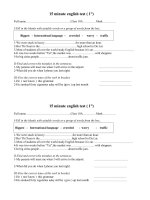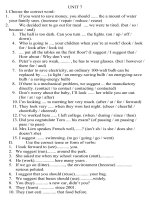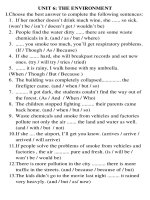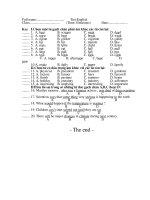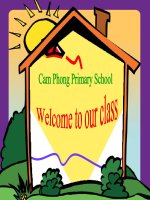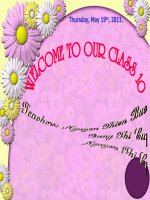Unit 15 tieng anh lop 8
Bạn đang xem bản rút gọn của tài liệu. Xem và tải ngay bản đầy đủ của tài liệu tại đây (96.28 KB, 9 trang )
Week:… The date of preparing:…./…./2009
Period:… The teaching:…/…./2009
UNIT 15 : INVENTIONS
Lesson : 1
Section: - Getting started
- Listen and read
I. Aim
Practice reading for details about the development of paper and how to produce chocolate .
II. Objective
By the end of the lesson , Ss will be able to know the origin of paper and talk about the process of producing
something .
III. Teaching aids:
Posters , cassette , realia , chart , pictures , grid chart .
PROCEDURE
I / Warm up : Quiz – Who did it ?
- Divide the class into 2 teams .
- Tell Ss the team raising theirt hands first will have the right to answer the question
- Inform the questions
“ Who was the inventor of ?
or “ Who invented ?
• Suggestions :
1. Steam engine -> Thomas Savery built the first steam engine in 1698 and later Watt improved it
2. Light bulb - > HumphryDavy , an English scientist , in 1800 .
3. Sewing machine -> Issac Meritt Singer ( 1850 )
4. Aqualung -> Jacques – Yves Cousteau in 1943.
5. Telephone -> A .Graham Bell .
Lead into the new lesson .
II / Pre- reading : Introduce the topic of the passage reading and some new words to Ss .
1. Pre- teach Vocabulary :
- to remove use a flowchart and Vietnamese to
- to crush elicit words
- to liquefy 1-> 2-> 3-> 4
- to grind
- to manufacture = to produce
- a process – manufacturing process
- a mold ( realia / picture )
- conveyor belt ( picture )
+ Have Ss copy in their note books .
• Checking vocabulary : Slap the board
2. Open predictions :
- Set the scene “ Tim jones , Hoa
,
s American pen pal , is visiting a chocolate factory with his class and his teaher .
Mrs . Allen. Now , guess who will show them around the factory and what they will learn from the visit . ?
- Ask ss to work in groups to predict .
- Collect their predictions and write them on the board .
III / While- reading :
1. Checking the their predictions
- Play the tape and ask Ss to listen while reading the dialogue
( 2 times )
- Have them correct their predictions and give feedback
2. Matching :
- Ask ss to match the half sentences
- Play the tape again ( 3 times ) and have Ss compare their answer with their pictures .
- Call on Ss to give their answers for the class .
- Give feedback and correct
Answer Key :
E a) The beans are cleaned before being cooked
D b) Mr . Roberts thought Tim and Sam were going to touch the button .
C c) After cooking , the cooa bean smell like chocolate
F d) Sugar is one of the ingredients in chocolate
B e ) Mrs . Allen warned Sam to leave some chocolate for others .
A f) A sample of chocolate is given after visitors have toured the factory .
=> Call on some pairs to read the dialogue in front of class .
- Correct mistakes if any .
- Get ss to write the full sentences in their exercise notebooks .
IV / Post - reading :
1 . Grid :
- Put the grid on the board and have Ss copy .
- Ask ss to read the dialogue again and fill in the grid .
Answer Key :
1. The beans are washed , weighed and cooked .
2. The shells are removed .
3. The beans are crushed and liquefied
4. Cocoa butter , sugar , vanilla and milk are added .
5. The mixture is ground , rolled and pound into the molds
- Call on some pairs to go the board to write their answers .
- Give feedback and correct .
2. Rewrite the grid using sequence markers
( First , next , then , finally )
V/ Homework :
1. Learn by hear new words and write two line for each one .
2. Copy the write in their notebooks .
3. Do the exercises in the workbook .
4. Prepare the next lesson.
Week:… The date of preparing:…./…./2009
chocolate manufacturing process
Period:… The teaching:…/…./2009
UNIT 15 : INVENTIONS
Lesson : 2
Section: - SPEAK + LISTEN
I. Aim
Futher practice in using the passive.
II. Objective
By the end of the lesson , Ss will be able to talk about the inventions using the passive .
III. Teaching aids: tables
PROCEDURE
I / Warm up : : Bingo
- Get Ss to brainstorm a list of 10 words and write them on the board .
foreman . process , manufacture , remove , crush , liquefy , grind , pour , mold , conveyor belt
- Ask ss to choose any 4 words and copy them into their paper .
- Call out the words until someone has ticked all of his / her words and shouts “ Bingo “
II / Pre- speaking : Introduce the topic of the speaking and some new words to students .
1. Pre-teach Vocabulary :
- Have ss study the meanings of the inventions using Vietnamese .
1. Facsimile
2. Reinforced concrete
3. Microphone
4. Loudspeaker
5. Helicopter
* Checking vocabulary : Which words
2. Grammar Awareness
- Ask ss to read the dialogue / 148 again and pick out all of the passive sentences .
- Call on Ss to give their answer .
- Have ss review the passive in the present and past simple tenses .
Answer Key :
1. This is where the cocoa beans are stored ( present simple )
2. That button can not be touched ( passive with model )
3. The beans are washed , weighed and cooked here .
4. After the shells are removed into molds .
III / While- Speaking :
1. Practice : Word- Cue Drill
- Have Ss read the model dialogue on 149
- Let Ss know what they are going to do :
Ask and answer questions about the inventions to fill in the missing information
- Ask ss to look at the tables on 150 and 156 and model the exchanges , using a good student .
- Have Ss work in pairs , one looks at the table / 150 and the other / 156 .
- Ask Ss to ask and answer the questions orally then fill in the missing information
- Go around and assist Ss if necessary
- Call on some pairs to demonstrate the exchanges .
- Give feedback and correct .
- Have Ss copy the complete table .
Invention Date Inventor Nationality
Printing Press 1810 Friedrich Koenig German
Bicycle 1816 Karl D.
Sanerbronn
German
Facsimile 1843 Alexander Bain English
Sewing machine 1845 Elias Howe American
Reinforced
concrete
1849 F.J . Monier French
Microphone 1878 D.E Hughes American
X-ray 1895 Wilhel Konarad German
Loudspeaker 1924 C.W.Rice American
Helicopter 1939 Igor Sikorsky American
Color TV 1950 Peter Carl Gold
mark
American
Optical fiber 1955 Narinder Kapany German
Laser 1958 Gordon Gould American
IV / Post - speaking : Making reports
- Model and have Ss repeat
Example : The Printing Press was invented by Friedrich Koenig in 1810.
- Ask Ss to use the complete table to report what they have found .
V / Pre-listening : Introduce the topic of the listening and some new words to students .
1. Pre-teach vocabulary :
- Procedure (n) ( Translation )
- Pulp (nu) -> What is used to make paper ?
- Vat (n) ( picture / drawing )
- to drain = to make something empty or dry by removing all the liquid from it )
- Roller (n) ( picture )
- Roll (n) ( realia )
=> Have Ss copy .
VI / While -listening :
Gap fill ( Listen 1 )
- Inform the topic : Paper – making process .
- Have Ss read the sentences .
- Play the tape 2 or 3 times and ask ss to fill in the gaps with the words they catch .
- Ask ss to compare their answers with their partners .
- Call on Ss to give their answers .
Answer Key :
1. simple 2. same 3. two hundred 4 left 5. rollers
- Call on some Ss to read the complete sentences in front of class .
VII / Post - reading :
Ordering Prediction ( Listen 2 )
- Ask ss to read the sentences (a-> g ) carefully and guess the order .
- Ask Ss to work in groups to predictions
- Collect their predictions and write their predictions on the board .
- Play the tape again and ask Ss to listen.
- Call on Ss to give their correction .
- Give feedback and correct :
Answer key :
c. Paper pulp was placed in the vat .
d. Paper pulp was mixed with water .
a. The water was drained .
e. The pulp fibers were poured out .
g. The pulp was conveyed under the rollers .
f. The fibers were smoothed and pressed dry .
b. The paper was put on a roll .
=> Call on some Ss to read the complete sentences aloud .
- Get them to copy their notebooks .
VIII/ Homework :
1. Learn by heart new words and write two lines for each one .
2. Use the information in the table to write 12 sentences in the notebooks .
3. Prepare the next lesson.
Week:… The date of preparing:…./…./2009
Period:… The teaching:…/…./2009
UNIT 15 : INVENTIONS
Lesson : 3
Section: - Read
I. Aim
Listening and reading for information about paper making & inventions
II. Objective
By the end of the lesson , Ss will be able to fill in the gaps and order sentences from listening.
III. Teaching aids: cassette , , chart , pictures
PROCEDURE
I / Warm up and pre-teach :
Brainstorming
Microwave
( May be write the names of the things in Vietnamese )
Remark and introduce some new words in English :
- Microwave (n) : vi sóng
- Vacuum (n) : máy hut bụi
- Toaster (n) :máy nướng bánh mì
- Have Ss copy
* Checking vocabulary : Bingo
- Get Ss to brainstorm a list of 10 new words and write them on the board .
- Have Ss choose any 4/5 words and copy them into their paper - Call out the words until someone has ticked all of
their words and shout “ Bingo “ and wins .
( microwave , vacuum , hairdryer , dishwasher , telephone , toaster , washing machine , )
II/ While- reading : Matching
- Get Ss to read the poem / 151
- Ask some questions to help them understand the reading more .
Household
Appliances
+ What is the first verse about ?
+ Is the second verse about the appliances used in the kitchen ?
+ What are “ doom , chugga-chug , vroom , boom ?
- Have Ss match the headings to the verses / 152 .
- Call on Ss to give their answers .
- Give feedback and correct .
Answer key :
Verse 1 : b. Appliances that cooked food .
Verse 2 : c. Appliances that clean or dry things .
Verse 3: a . Instrument invented by Alexander Graham Bell .
- Get Ss to copy in their notebooks .
III/ Post - reading : Gap fill
- Tell Ss to read the sentences carefully and fill the gaps with the inventions taken from the poems .
- Have ss compare their answers with their partners .
- Call on ss to give their answer and correct
Answer key :
1. Vacuum 2. Telephone 3. Washing machine
4. Microwave 5. Hair dryer 6. Toaster
- Call on some ss to read the complete sentences aloud .
- Have Ss copy their notebooks .
IV / Homework :
1. Learn by heart all the things they have learnt and copy in their notebooks .
2. Do the exercises in the workbook.
3. Prepare the next lesson .

